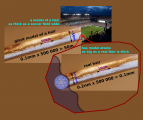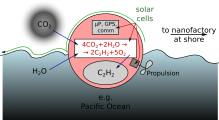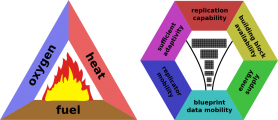Difference between revisions of "Mechadense's Wiki about Atomically Precise Manufacturing"
(→Towards the far term: added heading === Limits to the ambitions === +improved section) |
(→Limits to the ambitions: quite some improvements) |
||
| Line 78: | Line 78: | ||
But that is even beyond the far term goal of [[nanofactory|gem-gum factories]]. | But that is even beyond the far term goal of [[nanofactory|gem-gum factories]]. | ||
| − | Due to the strong "pessimism" (more formally "conservativeness") of [[exploratory engineering]] '''the [[nanofactory|reliably predictable part of | + | Due to the strong "pessimism" (more formally "conservativeness") of [[exploratory engineering]] '''the [[nanofactory|reliably predictable part of future tecnology]] is just the innermost naked core of what will really emerge'''. Part of this "innermost naked core" are just a few base materials. |
| − | Much stuff that cannot yet be expected from the [[incremental path]] (including fundamentally unpredictable scientific discoveries) may remain in the final systems. But there | + | But these few alone are, when made into (mechanical) metamaterials, already sufficient for the emulation of an overwhelming plethora of material properties that goes far beyond what we have today (2017). |
| + | |||
| + | Much of the stuff that cannot yet be expected from the [[incremental path]] (including fundamentally unpredictable scientific discoveries) may remain in the final systems. But there also often will be [[Consistent design for external limiting factors|strong reasons to ditch earlier technology]] to not unnecessarily limit the range of situations in which the [[Products of advanced atomically precise manufacturing|advanced products]] will be usable in. | ||
= Links = | = Links = | ||
Revision as of 13:14, 9 September 2017
| Language: en | Sprache: de |
- Intro: Here is a detailed introduction to atomically precise manufacturing as a whole.
- The DAPMAT demo project
The far term goal
 A personal desktop gem-gum factory fabblet with dynamically deployed protective hood. |
The personal gem gum factory is:
The personal gem gum factory makes:
|
The existence of a personal fabricator will have profound impact human society on a global scale. The basis for such a personal fabricator - the atomically precise manufacturing (APM) technology - is beginning to be figured out today.
Guided Tour
A general introduction to atomically precise manufacturing. It is meant for a wide target audience ranging from newbie to expert and from young to old. It is still a far stretch from being in a somewhat coherent state so please excuse the links dangling into construction sites.
|
Atomically Precise Manufacturing (APM) – near term & far term
What APM is absolutely not
While early APM may have overlap with these areas the far term goals are completely and utterly different.
- soft nanomachines, molecular biology, synthetic biology – Main article: "Brownian technology path"
What APM actually is
APM is basically the capability of manufacturing products such that the atoms they are constituted of link (bind) to each other in "exactly" the way one desires them to. Since "absolute exactness" in other words "making no errors ever" is a fundamental physical impossibility one just aims for extremely low error rates. On the long run error rates comparable to the bit-error-rates one can find in todays digital data processing systems.
Today and near term
Pick and place assembly of single atoms (or molecule fragments) is not at all a necessity for early forms of APM.
In fact pick and place assembly is not needed at all for early forms of APM.
Thermally driven assembly (aka "self assembly") can do the job.
- Thermally driven assembly is not present in macroscale manufacturing and therefore not present in our intuition.
Some scientists suspect APM proponents/fans to not get this so check it out. - Thermally driven assembly has error rates that are barely low enough to get started climbing the "stiffness ladder".
It may come somewhat unexpected but in early APM systems there is no need for the atoms to stay in place.
No, that does not contradict the introduction earlier. The atoms still need to keep their links/bonds to their neighbors. But in the early atomically precise systems of today (e.g. foldamers) the atoms tend to be bonded together to zig-zag chains.
Since many bonds can and do rotate the whole chains may deform. Thereby atoms can be displaced much more than their own diameter.
In summary: While APM systems must always be topologically precise positional precision is reserved for the more advanced forms of APM.
In some sense even chemistry could be counted as the earliest form of APM. But APM specifically focuses on scaling up APM capabilities to bigger sizes and chemistry is on the very bottom and does not scale up well.
Towards the far term
There are two core ideas that determine what the R&D direction from early forms of APM to advanced forms of APM actually is. This wiki will refer to those two ideas with the shorthand "gem-gum". This shorthand has been chosen since:
- it is catchy, in other words easy to spell and remember.
which "high throughput atomically precise manufacturing level technology" is not. (Source of that ridiculously long term: "Radical Abundance") - it is highly specific and thus hard to annex by other concepts. It very clearly points to the far term goal
which "high throughput atomically precise manufacturing level technology" does not.
Gem – Gemstone – Stiffness
Core idea #1 Gem: Short for high stiffness gemstone like compound.
Gradual increase of the stiffness of the materials we build with is the ultimate key to raise our level of control over matter (the key to advanced mechanosynthesis). The term "gem" (short for gemstone - obviously) points exclusively to the ideal stiff base materials of the far term target technology. This explicitly excludes early stage atomically precise manufacturing such as "structural DNA nanotechnology"
Gem-Gum – Gum/Rubber made out of gemstone
Core idea #2 Gem-Gum: Short for gemstone based mechanical metamaterials with seemingly contradicting and impossible properties.
Even when one can mechanosynthesize almost nothing (just a few simple base materials) one can make almost anything by mechanical emulation. This is the "magic" of mechanical metamaterials. "Gum" is just a shorthand for one concrete example of such a metamaterial that rhymes on "Gem" which makes memorization a lot easier. Also it's a concrete example that's rather un-intuitive. Rubber made from gemstone. This could peak interest (click-bait effect).
Even with very minimal high stiffness nano-manufacturing capabilities (just one single high performance compound like e.g. diamond and nothing else) the amount of materials creatable will far exceed what is available today. (TODO: add visualization)
Limits to the ambitions
APM is sometimes said to have the goal to:
- Create most arrangements/patterns of atoms that are permitted by and consistent with physical law.
But that is even beyond the far term goal of gem-gum factories.
Due to the strong "pessimism" (more formally "conservativeness") of exploratory engineering the reliably predictable part of future tecnology is just the innermost naked core of what will really emerge. Part of this "innermost naked core" are just a few base materials. But these few alone are, when made into (mechanical) metamaterials, already sufficient for the emulation of an overwhelming plethora of material properties that goes far beyond what we have today (2017).
Much of the stuff that cannot yet be expected from the incremental path (including fundamentally unpredictable scientific discoveries) may remain in the final systems. But there also often will be strong reasons to ditch earlier technology to not unnecessarily limit the range of situations in which the advanced products will be usable in.
Links
Webpages
- Forum
- Foresight Institute: Nanotechnology
- Disquisition 2013 "Nano-solutions for the 21st century: Unleashing the fourth technological revolution"
- Zyvex's definition of APM
- Other sites
Brief introduction videos
- Nanotube TV (von Nanotechnology Industries) (2016-10)
- Nanotechnology: the big picture with Dr Eric Drexler and Dr Sonia Trigueros (2016-01-28)
- Transforming the Material Basis of Civilization | Eric Drexler | TEDxISTAlameda (2015-11-16)
- Chris Phoenix on Molecular Manufacturing (2014-09?) (alternative 2)(alternative1) Nanotechnologist (older dead link)
- Dr Eric Drexler - Remaking the 21st Century (2014-01-23) long! 1h 14min
- Video of oxford talk (2014-01-22): Eric K. Drexler speaks about his new book "Radical Abundance"
- John Randall: "Atomically Precise Manufacturing" at Foresight Technical Conference 2013
Illuminating Atomic Precision: Foresight Technical Conference January 2013 - Fully Printed (2010-06) - Note: Diamondoid nanofactories will look and work differently and won't produce food.
- Ralph Merkle - An introduction to Molecular Nanotechnology (2009-11)
- presentation by Phillip Moriarty (2009-09):
SENS4 - Molecular Nanotechnology in the Real World: How Feasible is a Nanofactory?
(1/4) - (2/4) - (3/4) - (4/4) - Nottingham Nanotechnology debate (2005-08-24):
(recording of the whole debate)
Unfortunately videos got deleted :(
(1/7) - (2/7) - (3/7) - (4/7) - (5/7) - (6/7) - (7/7) -- repaired links (7/7)
- BBC Horizon Nanoutopia (1995)(broken link#2) (older broken link) - Note: The term "nanotechnology" turned out to be to unspecific and the assembler concept is now superseded by the nanofactory concept. The complexity of a nanofactory will be akin to modern day computer chips.
Locally hosted files
- Slides from the talk the apm-wiki site admin gave at the austrian "linuxwochen" event: slides-pdf-file




